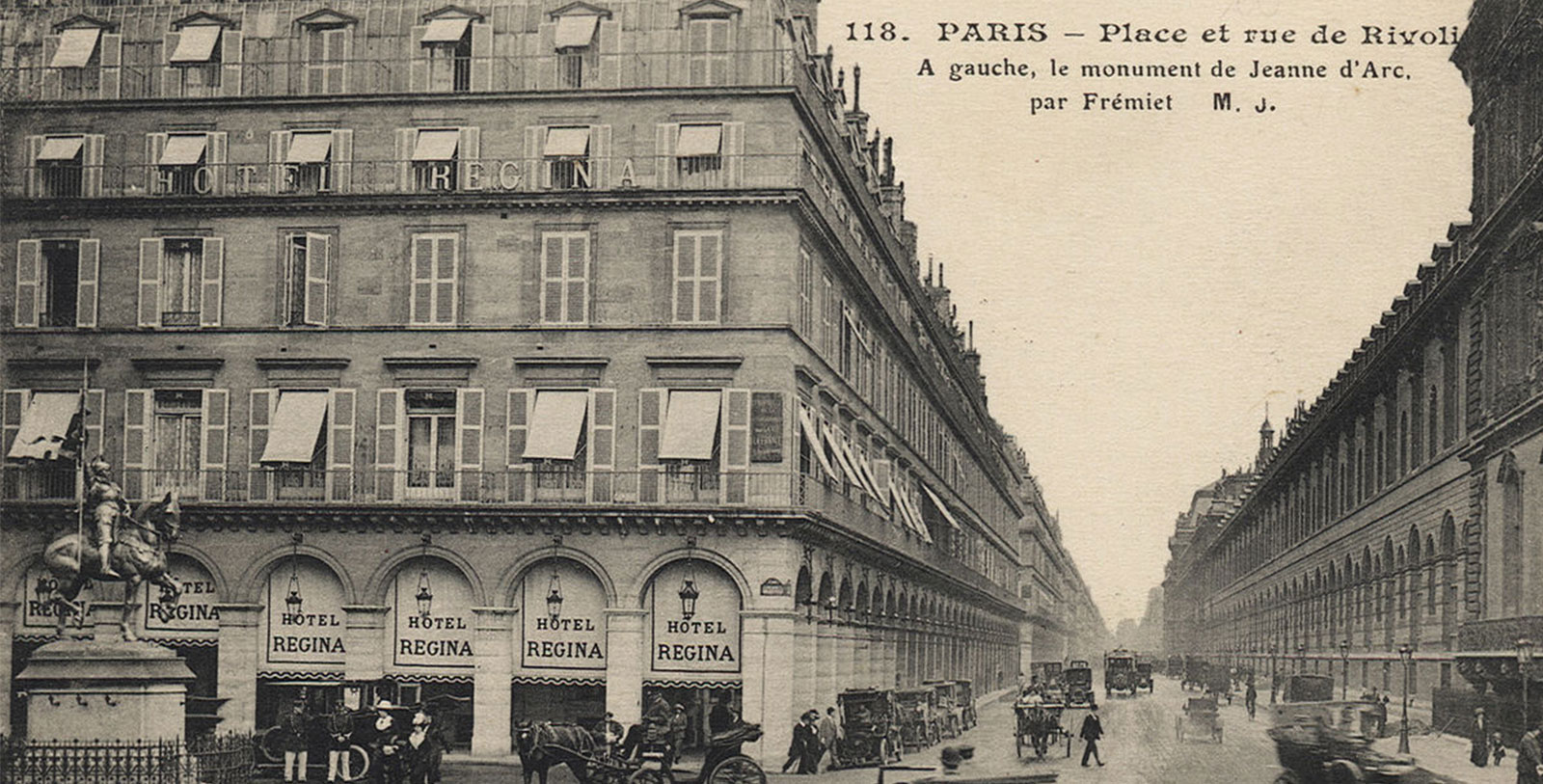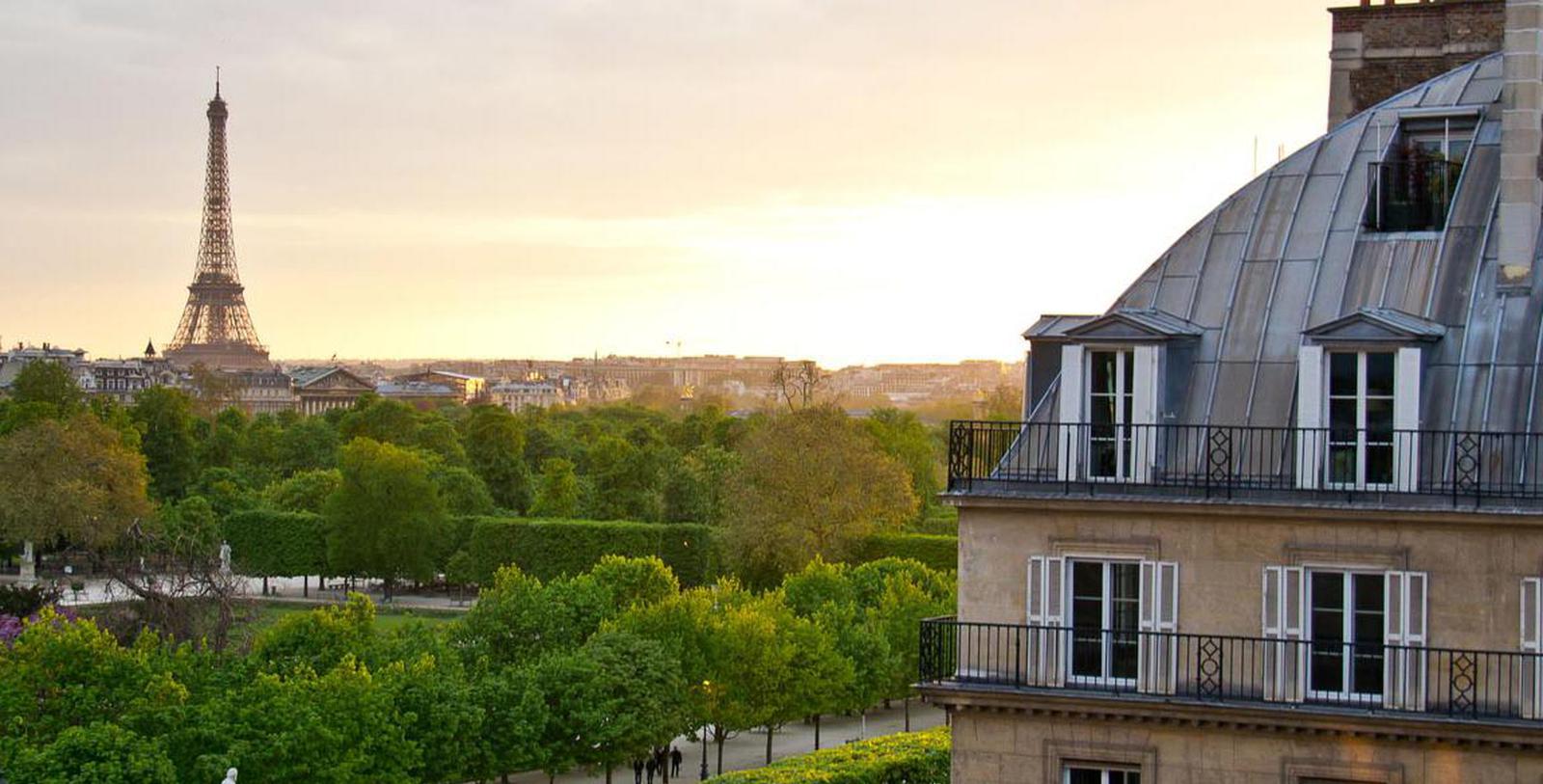Receive for Free - Discover & Explore eNewsletter monthly with advance notice of special offers, packages, and insider savings from 10% - 30% off Best Available Rates at selected hotels.
history
Discover Hotel Regina Louvre, which occupies the site of the royal stables and carousel for the Louvre Palace.
Hotel Regina Louvre, a member of Historic Hotels Worldwide since 2012, dates back to 1900.
VIEW TIMELINEIn 1898, two aspiring hoteliers named Léonard Tauber and Constant Baverez decided to open a luxurious boutique hotel in downtown Paris near the banks of the Seine. They settled on opening their business within a residential space located in the historic Places des Pyarmides. Once the site of a royal horse-riding school known as the Academie d’Equitation, the Place des Pyramides was among the most visited areas in the city following the installation its statue depicting the legendary Joan of Arc. They tasked architect Armand Sibien to turn their dream into a reality. Using a team of skilled artists and craftsmen, Sibien transformed the inconspicuous apartment complex into a stunning world-class hotel in just two years. Sibien managed preserve the building’s beautiful Art Nouveau-style architecture, restoring its many unique structural features in the process. His crew reinvigorated the historic layout by refurbishing its original decorative paneling and interior mosaics. Sibien also installed may new structural components, including new lighting as well as a marvelous central staircase. When construction finally concluded in time for the 1900 Paris Exposition, Hotel Regina was among the finest holiday destinations in the entire city.
The descendants of Constant Baverez still operate the Hotel Regina Louvre, as the fourth generation of his family currently oversees its day-to-day management. They specifically look after the building by means of a luxury hotel chain called Les Hôtels Baverez that Constant first founded in 1900. This fabulous brand not only manages the Hotel Regina Louvre, but two other historic hotels, as well: Hôtel Raphael and the Majestic Hôtel-Spa. The Baverez family has taken their stewardship of the Hotel Regina Louvre seriously, as they have sought to provide all of the modern comforts while preserving its rich historical character. They have subsequently enacted a series of renovations throughout the 2010s that kept the building’s appearance both fresh and authentic. Between 2013 and 2015, the Baverez’s spent more than €17 million in restorations so that guests could continue to appreciate hotel in the same way they had for more than a century. There are truly few places better for a memorable vacation in the City of Lights than the Hotel Regina Louvre. Hotel Regina Louvre is a member of Historic Hotels Worldwide.
-
About the Location +
Located along the Rue de Rivoli, Hotel Regina Louvre resides within a historic public square known as the Place des Pyramides. This outstanding destination faces the western end of the Jarden des Tuileries (Tuileries Garde), which travelers can easily access by way of the Avenue du Général Lemonier. The Place de Pyramides was named in honor of the Battle of the Pyramids, in which Emperor Napoléon Bonaparte defeated the Ottoman Turks just outside of Cairo in the Napoleonic Wars. Yet, long before the establishment of the Place de Pyramides, the area was the site of a royal horse-riding school administered by Antoine de Pluvinel. Known as the Academie d’Equitation, it taught many French noblemen to ride horses throughout the 16th century. Several French kings even enrolled during their youth, including Henry III, Henry IV, and Louis XIII. A plaque rests above the entrance to the Hotel Regina Louvre’s restaurant that commemorates this regal academy.
The most defining feature of the Place des Pyramides is the spectacular bronze statue of the mythical Joan of Arc mounted at its center. Following the defeat of France by their Prussian rivals in the Franco-Prussian War, French officials decided to raise a statue in her honor in downtown Paris. Joan of Arc was a legendary national figure hailed for her triumphs over the English during the Hundred Years’ War. As such, many local leaders had hoped that her likeness would re-instill a sense of national pride into the collective French psyche. Artist Emmanuel Frémiet sculpted the statue in the early 1870s, finishing it completely in 1874. Although Frémiet was said to have disliked the appearance of the monument, the citizens of Paris adored it. They subsequently inaugurated the statue with a massive unveiling later that year, which was attended by the last reigning monarch of France—Emperor Napoléon III.
Hotel Regina Louvre and the Place des Pyramides are part of the much larger First Arrondissement. Among the most historic of the city’s 20 administrative districts, the First Arrondissement was developed over a portion of an ancient Roman settlement dating back to the 1st century A.D. This community soon bore the Latin name of “Parisius” by the time the Western Roman Empire fell some three centuries later, eventually evolving into the word “Paris.” The district would go on to become the heart of medieval Paris, as the city itself morphed into the capital for the powerful Kingdom of France. From Paris, powerful noble families ruled over the land for centuries, such as the Capetians and the Valois. As such, the entire First Arrondissement is protected by UNESCO as a World Heritage Site called the “Banks of the Seine.” The district is even home to many historic structures that symbolize Paris’ wonderful heritage, including the Musée du Louvre and the Domaine National du Palais-Royal.
-
About the Architecture +
When Léonard Tauber and Constant Baverez decided to transform a residential structure at the Place des Pyramides into a wonderful boutique hotel, they hired architect Armand Sibien to make their dream become a reality. Sibien chose to preserve the structure’s beautiful stone exterior that previous architects had erected based upon the principles of Art Nouveau-style architecture. The building’s façade also displayed exquisite wall motifs carved throughout its surface, as well as beautiful stained-glass windows fitted with wooden window frames. Inside, Sibien reinvigorated the historic layout by refurbishing its original decorative paneling and interior mosaics. Craftsmen and artists endeavored to preserve its soon-to-be famous green ceramic tiles that had been installed throughout the ground floor. Brand new crystal chandeliers hung from the ceilings, while a new central staircase brilliantly reflected the structure’s historical appearance.
Hotel Regina Louvre received another series of extensive renovations in 2013, which was the first time it had undergone such a project since it first opened. The Baverez family chose to focus its initial work on the hotel’s secondary wing, before gradually expanding its scope to address the entire structure. Costing some €17 million to complete, the construction sought to revitalize the building’s architecture from the Belle Époque. The work restored most of its original features, including the stained-glass windows and the detailed wall decorations. The efforts of the Baverez’s to thoroughly reconstruct the building earned them great praise and enabled the Hotel Regina Louvre to earn its coveted five-star rating. But the Baverez family continued to work on the hotel over the next several years, restoring the front entrance’s iconic revolving door in 2016 and adding a number of new luxurious facilities in 2018.
-
Famous Historic Events +
Paris Exposition (1900): While the Hotel Regina Louvre did not directly affect the 1900 Paris Exposition, Léonard Tauber and Constant Baverez intended for the business to cater to guests arriving for the event. Held all over Paris between April and November, the Paris Exposition was an international fair meant to showcase the world’s many recent technological achievements. Many people saw novel machines for the first time, such as the escalator, the diesel engine, and the telegraphone. People viewing the fair’s many exhibits were supposed to feel a sense of global progress that would hopefully characterize the 20th century. Local administrators and real estate developers constructed dozens of new buildings across the city for exclusive use by the Paris Exhibition, too. A few of these structures still stand today, including the Grand Palais, the Petit Palais, and the Gare d’Orsay (now the Musée d’Orsay). By the time the fair ended, more than 50 million people had attended the event.
Founding of the International Federation of Red Cross and Red Crescent Societies (1919): Today, the International Federation of Red Cross and Red Crescent Societies is an international humanitarian organization that provides aid to over 160 million people throughout the world. It currently presides over 192 different groups that operate underneath its administrative umbrella, which are staffed by some 97 million employees and volunteers. Based out of Geneva, Switzerland, it is responsible for granting access to life-saving services that many disaster-stricken communities would be unable to normally receive. The International Federation of Red Cross and Red Crescent Societies offers its help regardless of the situation, whether it would be relief for a disease pandemic or cleanup in the wake of a traumatic earthquake.
The founding of this famous charitable organization came about in response to the destruction wrought from World War I. At the behest of Henry P. Davidson—Chairman of the American Red Cross’ “War Committee”—representatives from the National Red Cross Societies of the Allied Powers met at the Hotel Regina Louvre to discuss stronger international cooperation in providing aid to the beleaguered people of war-torn Europe. With the backing of U.S. President Woodrow Wilson and British general Sir David Henderson, Davidson pushed for the creation of an international governing body that could better manage the initiatives of the Red Cross’ worldwide branches. As such, Davidson guided officials from America, Great Britain, France, Italy, and Japan to create the “International Committee of the Red Cross.” A precursor to the International Federation of Red Cross and Red Crescent Societies, this group became instrumental in overseeing countless global relief efforts for the remainder of the century.
-
Film, TV and Media Connections +
The Lady Banker (1980)
The Blood of Others (1984)
The Joint Brothers (1986)
La Femme Nikita (1990)
Same Old Song (1997)
Man is a Woman (1998)
Kiss of the Dragon (2001)
The Bourne Identity (2002)
Sagan (2007)
Female Agents (2008)
The Extraordinary Adventures of Adèle Blanc-Sec (2009)


























